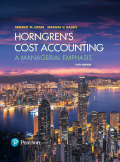
Contribution Margin:
The amount of the contribution margin is the difference between the selling price of per unit and variable cost of per unit. Here contribution is the part of the sales revenue.
Operating Income:
The outcome of deduction of operating expense and
Variable Cost:
The Variable cost is that cost which varies with increase or decrease in the level of production. The Variable cost of per unit remains same. Here, it can be said that variable cost has the positive relationship with output of production.
Fixed Cost:
The Fixed cost is that cost which does not change with increase or decrease in the level of production, but per unit fixed changes with change in the level production. Examples of the fixed cost are rent, wages and insurance.
To determine: Action taken by N to maximize its operating income and factor that should be considered before making decision.
Trending nowThis is a popular solution!

Chapter 11 Solutions
EBK HORNGREN'S COST ACCOUNTING
- Accounting problem with correct solutionarrow_forwardFinancial accounting 27.9.12arrow_forwardViola Enterprises purchased an item for inventory that cost $25 per unit and was priced to sell at $40. It was determined that the replacement cost is $22 per unit. Using the lower-of-cost-or-market value, what amount should be reported on the balance sheet for inventory? Helparrow_forward
- What role does transaction pattern analysis serve in control design? (4 PTS) (a) Random checks work better (b) Analysis wastes time (c) Patterns hold no meaning (d) Recurring sequence identification guides preventive measures MCQarrow_forwardI need guidance with this financial accounting problem using the right financial principles.arrow_forwardViola Enterprises purchased an item for inventory that cost $25 per unit and was priced to sell at $40. It was determined that the replacement cost is $22 per unit. Using the lower-of-cost-or-market value, what amount should be reported on the balance sheet for inventory?arrow_forward
- David Corp. manufactures 2 products, drills and wrenches. The company has estimated its overhead in the assembly department to be $200,000. The company produces 500,000 drills and 400,000 wrenches each year. Each drill uses 4 parts, and each wrench uses 5 parts. How much of the assembly overhead should be allocated to drills?arrow_forwardCorrect answer please general accountarrow_forwardWhat value should be allocated to the building?arrow_forward
 Cornerstones of Cost Management (Cornerstones Ser...AccountingISBN:9781305970663Author:Don R. Hansen, Maryanne M. MowenPublisher:Cengage Learning
Cornerstones of Cost Management (Cornerstones Ser...AccountingISBN:9781305970663Author:Don R. Hansen, Maryanne M. MowenPublisher:Cengage Learning Essentials of Business Analytics (MindTap Course ...StatisticsISBN:9781305627734Author:Jeffrey D. Camm, James J. Cochran, Michael J. Fry, Jeffrey W. Ohlmann, David R. AndersonPublisher:Cengage LearningPrinciples of Accounting Volume 2AccountingISBN:9781947172609Author:OpenStaxPublisher:OpenStax College
Essentials of Business Analytics (MindTap Course ...StatisticsISBN:9781305627734Author:Jeffrey D. Camm, James J. Cochran, Michael J. Fry, Jeffrey W. Ohlmann, David R. AndersonPublisher:Cengage LearningPrinciples of Accounting Volume 2AccountingISBN:9781947172609Author:OpenStaxPublisher:OpenStax College Managerial AccountingAccountingISBN:9781337912020Author:Carl Warren, Ph.d. Cma William B. TaylerPublisher:South-Western College Pub
Managerial AccountingAccountingISBN:9781337912020Author:Carl Warren, Ph.d. Cma William B. TaylerPublisher:South-Western College Pub



